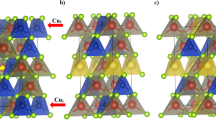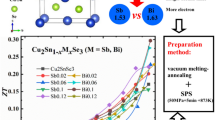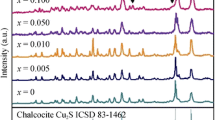Abstract
Cuprous chalcogenide, Cu2Se, attracted attention due to its large Seebeck coefficient coupled with low thermal conductivity, facilitated by the presence of disordered Cu-ions in the structure of Cu–Se. This compound is thermally unstable prompting investigation of its analogue Cu2Te which has a lower figure-of-merit zT due to its high charge carrier concentration. In the present work, a dual substitution, both cation and anion by Li and Se, respectively, has been attempted to enhance zT. The Cu2−xLixTe1−ySey alloys have been synthesized by a simple, conventional arc melting process and investigated without subjecting to any further processing. The room temperature microstructure shows a plate-like layered nanostructure in the grains with the grains oriented in random directions. The alloys at room temperature have two polymorphic phases, superstructured hexagonal and orthorhombic, co-existing in all the alloys. The alloys exhibit a degenerate semiconducting behavior in the range 300–1000 K with the conductivity decreasing from ~ 3000 Scm−1 to 700 Scm−1. All the alloys show a hole dominant Seebeck coefficient which increases with temperature from ~ 30 to 135 μVK−1. The alloy with dual substitution, Li-0.1 and Se-0.03, has the highest power factor of 1.6 mWm−1 K−2 at 1000 K. It’s low thermal conductivity in the complete range < 1.5 Wm−1 K−1 results in increasing the zT to 1.0 at 1000 K, an increase of 130% compared to the undoped alloy. These alloys are found to be thermally and temporally stable with no significant power loss either due to thermal cycling or aging.




Similar content being viewed by others
References
M. Hong, Z.G. Chen, J. Zou, Chin. Phys. B 27, 048403 (2018)
J.P. Heremans, V. Jovovic, E.S. Toberer, A. Saramat, K. Kurosaki, A. Charoenphakdee, S. Yamanaka, G.J. Snyder, Science 321, 554–557 (2008)
Y. Pei, A. LaLonde, S. Iwanaga, G.J. Snyder, Energy Environ. Sci. 4, 2085 (2011)
Y. Pei, A.D. LaLonde, N.A. Heinz, G.J. Snyder, Adv. Energy Mater. 2, 670–675 (2012)
H. Beyer, J. Nurnus, H. Böttner, A. Lambrecht, E. Wagner, G. Bauer, Phys. E 13, 965–968 (2002). https://doi.org/10.1016/S1386-9477(02)00246-1
F. El Akkad, B. Mansour, T. Hendeya, Mater. Res. Bull. 16, 535–539 (1981). https://doi.org/10.1016/0025-5408(81)90119-7
C. Zhou, Y. Yu, Y.K. Lee, O. Cojocaru-Mirédin, B. Yoo, S.P. Cho, J. Im, M. Wuttig, T. Hyeon, I. Chung, J. Am. Chem. Soc. 140, 15535–15545 (2018). https://doi.org/10.1021/jacs.8b10448
L. Yang, Z.G. Chen, G. Han, M. Hong, L. Huang, J. Zou, J. Mater. Chem. A 4, 9213–9219 (2016). https://doi.org/10.1039/c6ta02998a
R. Nunna, P. Qiu, M. Yin, H. Chen, R. Hanus, Q. Song, T. Zhang, M.Y. Chou, M.T. Agne, J. He, G.J. Snyder, X. Shi, L. Chen, Energy Environ. Sci. 10, 1928–1935 (2017). https://doi.org/10.1039/c7ee01737e
K. Okamoto, Jpn. J. Appl. Phys. Part 1 Regul. Pap. Short Notes Rev. Pap. 10, 508 (1971). https://doi.org/10.1143/JJAP.10.508
H. Liu, X. Shi, F. Xu, L. Zhang, W. Zhang, L. Chen, Q. Li, C. Uher, T. Day, G. Snyder Jeffrey, Nat. Mater. 11, 422–425 (2012)
A. Bohra, R. Bhatt, S. Bhattacharya, R. Basu, S. Ahmad, A. Singh, D.K. Aswal, S.K. Gupta, AIP Conf. Proc. 1731, 110010 (2016)
M.M. Mallick, S. Vitta, J. Appl. Phys. 122, 024903 (2017). https://doi.org/10.1063/1.4993900
K. Sridhar, K. Chattopadhyay, J. Alloys Compd. 264, 293–298 (1998)
Y. He, T. Zhang, X. Shi, S.H. Wei, L. Chen, NPG Asia Mater. 7, e210 (2015). https://doi.org/10.1038/am.2015.91
S. Ballikaya, H. Chi, J.R. Salvador, C. Uher, J. Mater. Chem. A 1, 12478 (2013)
Y. Qiu, Y. Liu, J. Ye, J. Li, L. Lian, J. Mater. Chem. A 6, 18928–18937 (2018). https://doi.org/10.1039/c8ta04993a
S. Sarkar, P.K. Sarswat, S. Saini, P. Mele, M.L. Free, Sci. Rep. 9, 8180 (2019). https://doi.org/10.1038/s41598-019-43911-2
K. Zhao, K. Liu, Z. Yue, Y. Wang, Q. Song, J. Li, M. Guan, Q. Xu, P. Qiu, H. Zhu, L. Chen, X. Shi, Adv. Mater. 31, 1903480 (2019). https://doi.org/10.1002/adma.201903480
M. Li, Y. Luo, G. Cai, X. Li, X. Li, Z. Han, X. Lin, D. Sarker, J. Cui, J. Mater. Chem. A 7, 2360–2367 (2019). https://doi.org/10.1039/c8ta10741f
N. Vouroutzis, C. Manolikas, Phys. Status Solidi 111, 491–497 (1989). https://doi.org/10.1002/pssa.2211110213
A.A. Sirusi, A. Page, C. Uher, J.H. Ross, J. Phys. Chem. Solids 106, 52–57 (2017). https://doi.org/10.1016/j.jpcs.2017.02.016
L. Yu, K. Luo, S. Chen, C.-G. Duan, CrystEngComm 17, 2878–2885 (2015)
Y. Zhang, B. Sa, J. Zhou, Z. Sun, Comput. Mater. Sci. 81, 163–169 (2014)
A.S. Pashinkin, V.A. Fedorov, Inorg. Mater. 39, 539–554 (2003)
Y.G. Asadov, L.V. Rustamova, G.B. Gasimov, K.M. Jafarov, A.G. Babajev, Phase Transitions 38, 247–259 (1992)
Acknowledgements
The authors wish to acknowledge DST and ISRO, Government of India and Central Facilities, Indian Institute of Technology Bombay for the support.
Author information
Authors and Affiliations
Corresponding author
Additional information
Publisher's Note
Springer Nature remains neutral with regard to jurisdictional claims in published maps and institutional affiliations.
Rights and permissions
About this article
Cite this article
Mallick, M.M., Vitta, S. Effect of double doping, Li and Se, on the high-temperature thermoelectric properties of Cu2Te. J Mater Sci: Mater Electron 31, 4129–4134 (2020). https://doi.org/10.1007/s10854-020-02960-4
Received:
Accepted:
Published:
Issue Date:
DOI: https://doi.org/10.1007/s10854-020-02960-4




